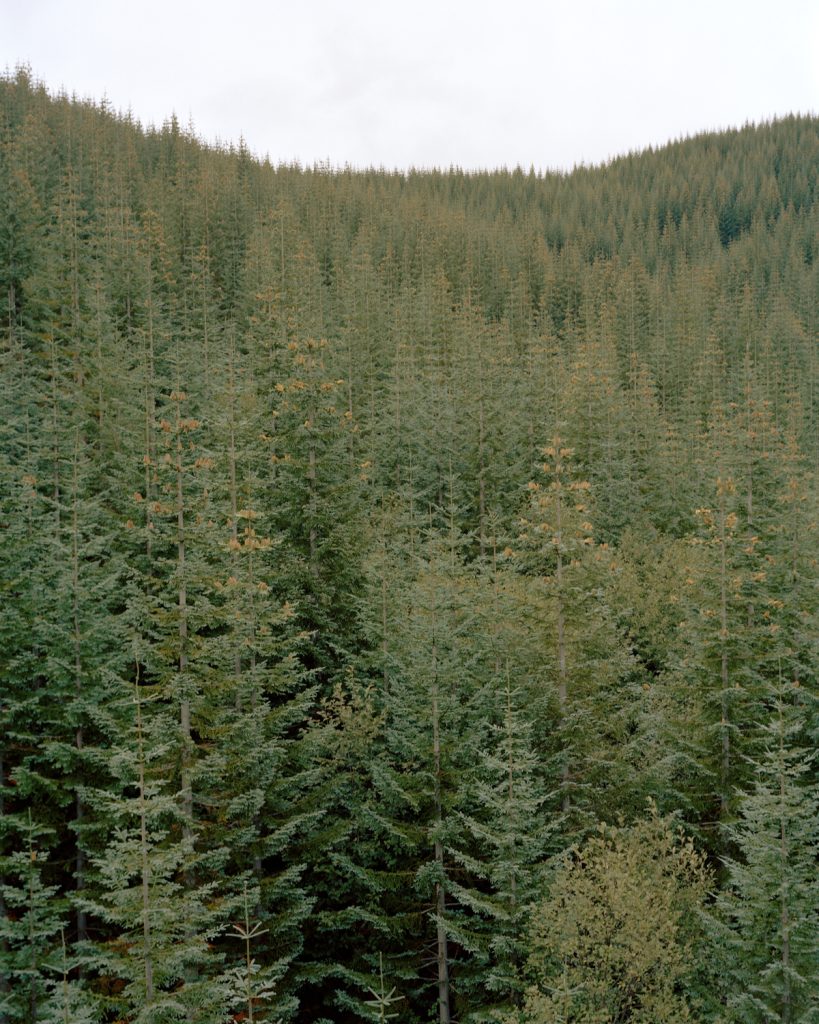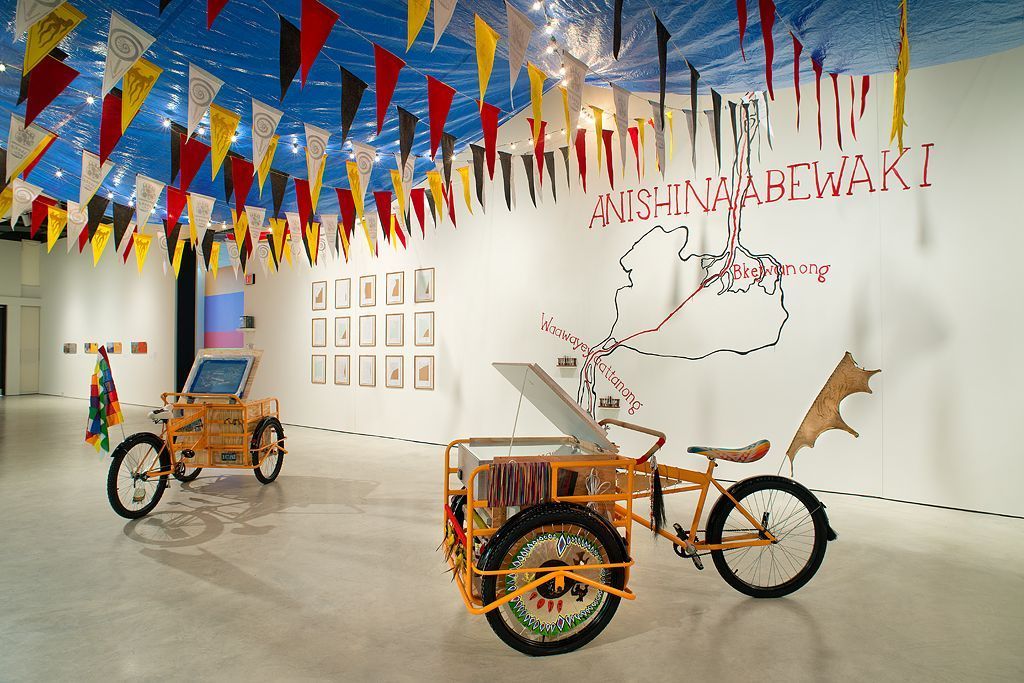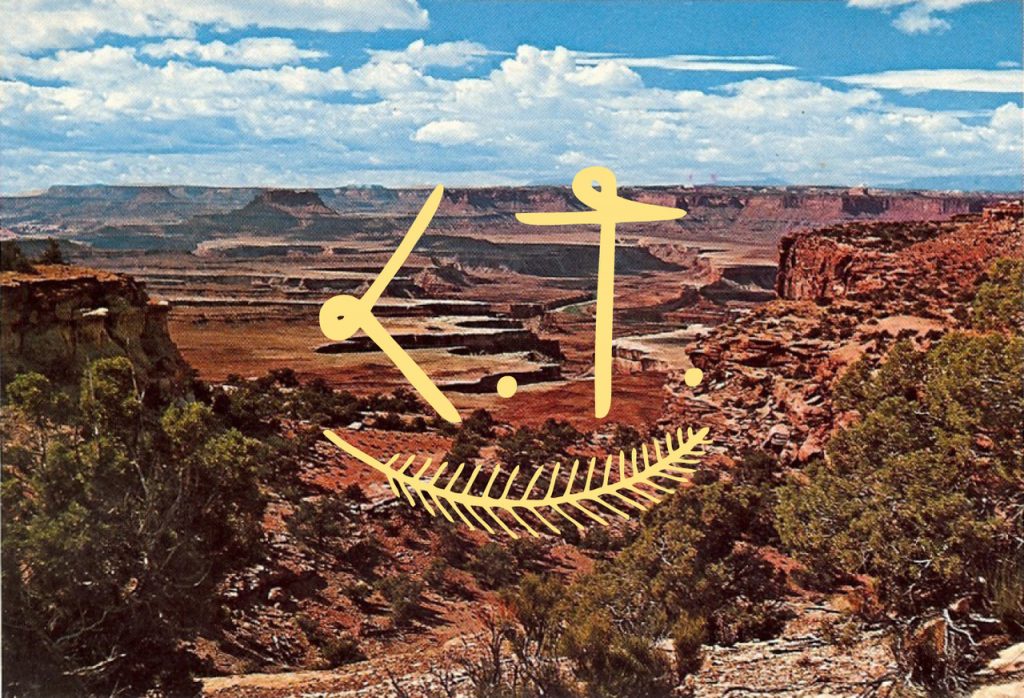This is the last week of our exhibition, Rabbit Island: Works and Research 2010-2013, at the DeVos Art Museum. If you are in northern Michigan before November 17th–last chance–stop in and see it in person.
For those unable to visit, photos from the opening and documentation of the work on display can be found at the DeVos Art Museum Flickr.
Thank you to museum director, Melissa Matuscak, and her staff for curating and installing an amazing exhibition. Thanks also to Edwin Robert Carter for designing a brilliant catalogue. A sincere thank you to all who have come to see the exhibition in person.
Melissa reported this earlier in the week: “We’ve had groups of all ages visit (literally from kindergartners to 90+) and everyone responds to the show with awe, interpreting it in very different ways. Six hundred and ninety-five students (K-12) came through a few weeks ago. Numerous groups from the university visited–not just art and design students but english, sociology, ecology, etc. A group of nail tech students even came through because they’d heard about Lucy Engelman’s illustrations and wanted to get inspired by new ideas for nail art! (I'm looking for photos of anything that came of the visit!) Just today, a group of early-stage alzheimer patients toured with Alzheimer Association staff and the photographs triggered conversations about their time visiting or living in the Keweenaw. The way the work has provoked the imagination of visitors has been fun to watch, not to mention what it says about the experience on Rabbit Island."
Finally, thank you to all the artists, designers, photographers, and writers who contributed such great work: Emilie Lee, Andrew Ranville, Charlotte X.C. Sullivan, Colin Curry, Cabin-Time 3 (Sarah Darnell, Ryan Greaves, Geoffrey Holstad, Isabella Martin, Miles Mattison, Colin McCarty, Mary Rothlisberger), LoT Office for Architecture (Leonidas Trampoukis & Eleni Petaloti), David Buth/Summer Journeys/Christina Mrozik, Emily Julka, Helen Lovelee, Lucy Engleman, Rob Gorski, Sara Maynard, Tony Cenicola and Will Holman.
Essay by Emilie Lee, realist painter and artist in residence on Rabbit Island in July and August, 2013, originally published by Stio in their seasonal catalog (where Emilie serves as an Ambassador). Her landscape paintings can be seen at the DeVos Art Museum as part of the Rabbit Island Works and Research 2010 - 2013 exhibit until November 17th.
It’s 5:30 AM when I open my eyes, it takes a moment for me to realize that I’m not in my own bed in Brooklyn, NY, where the air is a crushing 100 degrees. I’m in a sleeping bag and lots of layers, savoring this warmth as a cold wind drives through sparse trees around me. I can hear waves crashing, it sounds like the ocean. Rob is already yanking on his wetsuit and saying “Waves like this could sink the boat, we’d better move it before this weather gets worse!” I spring into action and grab my own suit, soon we are chest deep in the frigid waters of Lake Superior, hauling our bodies over the bucking sides of the 17 foot Boston Whaler. I wrestle with the mooring ropes as Rob starts the engine and in a minute we are riding that heaving turquoise water away from shore. It doesn’t take long for us to round the southwest point of land and suddenly the boat planes flat and we glide safely through smooth water. Protected from the wind, this scene is a world away from the one we just left – the sun is beginning to warm the day and gentle waves lap the rocks.
The shoreline feels worn thin by the constant forces of wind and water. The trees on the edge are small and wiry, the sandstone bedrock has crumbled into chunks under the summer waves and winter ice. By contrast the island interior is a riotous jungle of thick moss, impenetrable undergrowth, and sturdy old trees. No mammals larger than mice live here, so the flora has grown unchecked. A nesting pair of bald eagles watch over this rare, fragile ecosystem that is contained by the impossible expanse of the largest freshwater lake in the world.This is how I began my first morning on Rabbit Island, a ninety-one acre oasis of wilderness located three miles off the Keweenaw Peninsula in northern Michigan. The island is home to a small artist residency, one where the artists sleep in tents, cook over a campfire, and go fishing for dinner. The only shelter from the elements is a three sided cabin that serves as a communal kitchen and dining area. Residents are responsible for cooking and doing chores around camp but otherwise are free to roam the island and find inspiration in this unique environment.
And what a lake it is! It’s immensity is hard to grasp. If emptied, it would flood North and South America to a depth of one foot, it holds 10% of all the earth’s fresh water, and it’s surface area is larger than all of New England. I had been aware of these facts before, but during my two weeks as a resident artist on Rabbit Island I gained a more intimate reverence for Lake Superior.
I spent my time making small oil paintings, standing still for hours at a time, immersed in observing the water, rocks, moss, and sky. For three days in a row we endured weather that was 45 degrees and raining with waves so big that some of the artists were able to take out their surfboards and catch some rides! On these days I was cold and shivering at my canvas, but transfixed by the challenge of painting the storm. With my easel set up on the wet rocks I was just out of the water’s reach while it reared and crashed in my face. I could peer into the cold clear water while the wind whistled around my head, sensing the threatening power of the legendary lake and the safe shelter that this delicate island was offering me.
It’s October now, and I’ve been back in New York City for a couple months. My paintings from Rabbit Island have joined others on my studio wall - like little windows into my memory, I can look into each one and be transported back to the day I made it, complete with all the sounds, sights, smells, and emotions that I experienced. I’m using these small paintings as inspiration for much larger canvases, and while I’m working in my studio I can almost feel the shivering cold of those stormy days. Digging into this remembered experience on a daily basis, I’ve uncovered more than just colors, shapes, and values for my artwork. I recall the simplicity of my daily routine on the island and how little I needed to be happy. A cold dip in the lake, a hot bowl of oatmeal, and I was ready to paint all day.
Back in New York, my life has more complexity, and at times I feel like I’m fighting upstream to carve out the uninterrupted hours I need to paint. During this past month of transitioning I’ve seriously questioned my choice to live here, is it time to move on and find my nest in the woods? Weighing my options, my instincts voted unanimously to stay put. I don’t feel ready to flee the city for a more secluded life. Instead I’m thinking about ways to simplify my routine and make room for the things that matter: painting, family, friends, and time to be reminded of nature’s beauty and power. I need the opportunities to expand my mind, to continue learning, to be challenged and inspired by the rich culture of art around me.
Photos of the Rabbit Island: Works and Research 2010-2013 exhibition at the DeVos Art Museum in Marquette, Michigan. Additional photos from the opening as well as installation shots can be found on the DeVos Art Museum Flickr page.
The exhibition runs until November 17th. It is our hope that this show helps define and advance the concept that the artist has a responsibility to consider that which he/she creates from a fundamental perspective, and serves as a celebration of the idea that wilderness is, indeed, a grand symbol of civilization. Thanks again to the organizers at Northern Michigan University and all artists involved.
Press release from the DeVos Art Museum. Come join us tomorrow.
Rabbit Island: Works and Research 2010-2013
We’re very excited to announce the opening of “Rabbit Island: Works and Research 2010-2013” tonight at the DeVos Art Museum in Marquette, Michigan. The show will run from October 11th to November 17th.
The island’s residency program, in beta stage since 2010, has welcomed over 50 artists, designers, musicians, writers, chefs and other creative thinkers, yet the island has been left in its native state. As the official residency program is set to launch in 2014, this exhibition looks back on the past three years of projects inspired by and created on the island. It is both an experiment in and discourse on the intersection of creation, consumption and conservation, ideas we feel very strongly about and would like to push to the forefront of our culture.
The exhibition features works by Emilie Lee, Andrew Ranville, Charlotte X.C. Sullivan, Colin Curry, Cabin-Time 3 (Sarah Darnell, Ryan Greaves, Geoffrey Holstad, Isabella Martin, Miles Mattison, Colin McCarty, Mary Rothlisberger), LoT Office for Architecture (Leonidas Trampoukis & Eleni Petaloti), David Buth/Summer Journeys/Christina Mrozik, David Drennen, Emily Julka, Helen Lovelee, Lucy Engleman, Rob Gorski, Sara Maynard, Tony Cenicola and Will Holman. A full color, fully illustrated catalogue is available for purchase.
October 11 – November 17, 2013
The opening reception is Friday, October 11th, from 6-8pm, featuring live music by Jen Koppin and a culinary collaboration between NMU’s Chef Nathan Mileski and Chef Kelly Geary, former Rabbit Island Chef-in-Residence and Chef-Proprietor, Sweet Deliverance, NYC.
Andrew will be making a presentation about the Rabbit Island Residency tomorrow, October 1st, in Grand Rapids, Michigan. He’ll be speaking about the foundation of the program and what we have in store for the future at an ArtPrize event titled “Artist-Run Michigan”. Some info from the event website:
An incomplete inventory of artist-run initiatives in Michigan, featuring Paul Amenta of SiTE:LAB, Jerome Chu of Flint Public Art Project, Jenn Schaub of Avenue for the Arts, Geoffrey Holstad of Cabin Time, Wesley Taylor of Complex Movements, and Andrew Ranville of Rabbit Island Artist Residency. Each will give a short presentation about the past and future of their projects.
The talks kick off at 7pm. For those of you in the area come on out and say hello and ask any questions. The event is free and open to the public.
Congratulations: 2014 Supported Residents
We are excited to announce the awarded residencies for next summer. The following participants will receive funding to travel to the island starting June 2014 and their work will be featured in an exhibition and publication at the DeVos Art Museum in August-September 2014. The Rabbit Island Residency program will collaborate with the selected residents over the next 9 months to help refine their proposals, plan outcomes, and prepare them for living and working on the island.

+ Nich Hance McElroy, Vancouver-based photographer who’s work investigates the often incompatible notions of putting down roots (history, settlement, place-making and stewardship) and making a route (migration, entrepreneurship, way-making, and roaming). Proposal excerpt:
While Rabbit Island is a model case of responsible development, land stewardship and progressive thinking, it is also emblematic of the highly networked, globally aware and resource dependent realities of the twenty-first century. It is simultaneously a finite 91-acre island in Lake Superior and the convergence zone for countless modes of commute and communication, whether physical or digital, affective or literal.
What does a migratory population bring to a small and isolated ecosystem? How does the culture of temporary inhabitation brush against deep ecological commitments? To investigate these questions I hope to document the comings and goings of the island, in their human, material, and biotic guises.

+ Elvia Wilk, Berlin-based writer who’s critical and creative writing practices converge at the intersection of art, architecture, and networked technology, exploring the relationships between physical and virtual space. Elvia plans to produce two separate text-based works, a series of poems and an investigative essay. Proposal excerpt:
[I will] focus on questions I have begun investigating thus far in my work, beginning with the politics of isolation within today’s networked society. How has my relationship and understanding of nature been affected through the evolution of the technologies I use? Where is the dividing line between the “natural” environment and the created, virtual one?
Perhaps isolation is impossible today, but how would being surrounded by water on all sides for a chunk of time alter my mentality, my constant need for back-and-forth interaction through a server? Fittingly, water serves as both content and metaphor in much of my writing. I’m interested in juxtaposing its fluidity with the dichotomous, mathematical structure of our networked existences, and the often-rigid physical architecture characteristic of urban space. Does information “flow” through these systems like water? Are concepts so liquid as they appear?

+ Waboozaki group proposal (Dr. Dylan Miner, Dr. Julie Nagam, Dr. Nicholas Brown, and Suzanne Morrissette). A collaborative group who’s research investigates the Indigenous histories of the Great Lakes region, presents cultural remapping studies, and explores experimental – as well as experiential – geography. Proposal excerpt:
By extending the ecologically-based projects developed by [The Rabbit Island project] Waboozaki, these three Indigenous and one non-Native artists, will begin (or rather continue) thinking about the island and Lake Superior in relation to Indigenous notions of placemaking and mapping. … Collectively, the artists will explore notions of place, Indigenous history, the islands location in the US-Canada borderlands, its specific ecology and medicinal herbs, etc. While the artists will collectively address issues related to Native American mapping, they will also develop individual projects around similar themes.
Residency Application Update: We received 115 applications from 12 countries for the 2014 Rabbit Island Residency. Creative and smart proposals and were submitted in genres across the board: visual art, dance, music, writing, photography, mapping, interactive sound, poetry, landscape architecture, and many others. Each proposal has been a pleasure to review and we would like to sincerely thank everyone who applied. We are in the process of narrowing submissions to 3 funded residencies and plan to announce winners publicly on Monday, September 9th.
We are excited to be able to offer a small group of artists the opportunity to contemplate what it means to create on a remote island in Lake Superior. Thanks again, everyone.

Good luck to our friends at Cabin-Time at the start the of their fifth expedition, CT5: Green River. We’re looking forward to see what they’ll be working on in the dusty expanse of Desolation Canyon, Utah, especially our friends and previous Rabbit Island residents: Geoffrey Holstad, Sarah Darnell, Ryan Greaves, Mary Rolithsberger (CT3: Rabbit Island in 2012), Emily Julka (2012 and 2013), and Charlotte X.C. Sullivan (2013).
